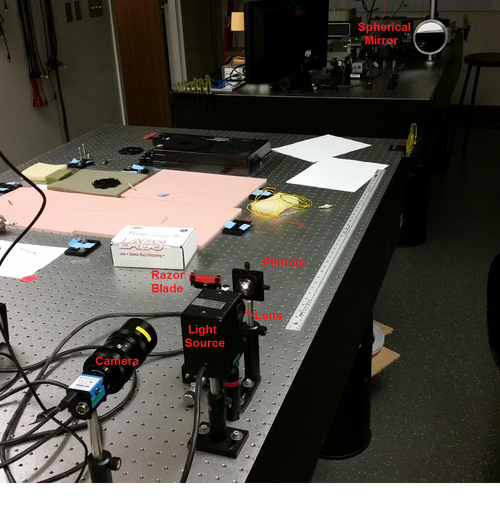Difference between revisions of "Schlieren Flow Visualization"
(→Schlieren Flow Visualization) |
|||
| Line 11: | Line 11: | ||
A light source is focused onto a pinhole to create a high intensity point source. The point source is located two focal lengths from a 6" spherical mirror (f = 1.5 m) to produce an image of the same size on a razor blade. The razor blade is positioned to block half of the light reflected by the mirror, while the other half of the light is picked up by the camera. The camera lens is focused on the objects held in front of the mirror. | A light source is focused onto a pinhole to create a high intensity point source. The point source is located two focal lengths from a 6" spherical mirror (f = 1.5 m) to produce an image of the same size on a razor blade. The razor blade is positioned to block half of the light reflected by the mirror, while the other half of the light is picked up by the camera. The camera lens is focused on the objects held in front of the mirror. | ||
| + | |||
| + | Objects held in front of the mirror will disrupt the air, changing the index of refraction, and thereby changing the amount of light which is blocked by the razor blade. Depending on whether the index of refraction of the air is increased or decreased, more or less light will be blocked by the razor blade, and therefore more or less light will be picked up by the camera. This produces an image where small changes in refractive index can easily be seen, allowing heat and gases invisible to the human eye to be easily seen. | ||
| + | |||
| + | == Experimental Results == | ||
Revision as of 13:35, 18 June 2015
Schlieren Flow Visualization
Schlieren Flow Visualization is an optical technique used to visualize small changes in the index of refraction in air.
Experimental Setup
A light source is focused onto a pinhole to create a high intensity point source. The point source is located two focal lengths from a 6" spherical mirror (f = 1.5 m) to produce an image of the same size on a razor blade. The razor blade is positioned to block half of the light reflected by the mirror, while the other half of the light is picked up by the camera. The camera lens is focused on the objects held in front of the mirror.
Objects held in front of the mirror will disrupt the air, changing the index of refraction, and thereby changing the amount of light which is blocked by the razor blade. Depending on whether the index of refraction of the air is increased or decreased, more or less light will be blocked by the razor blade, and therefore more or less light will be picked up by the camera. This produces an image where small changes in refractive index can easily be seen, allowing heat and gases invisible to the human eye to be easily seen.

